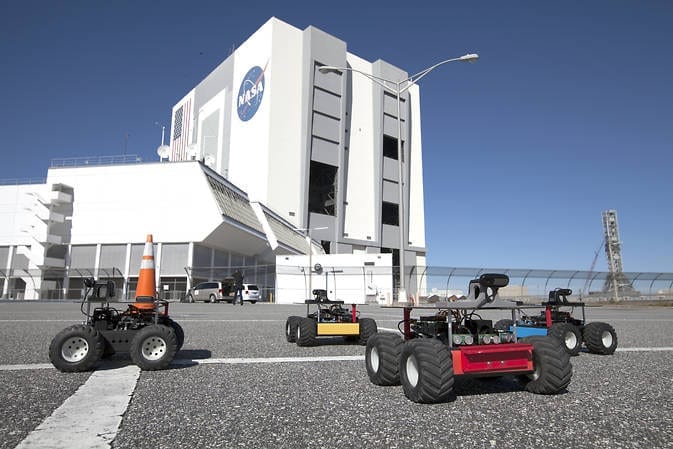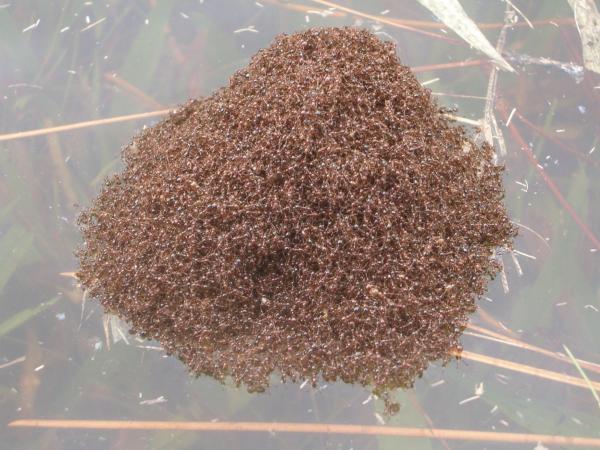
Image Credit: NASA/Dmitri Gerondidakis
The approach could be put to use in the future in service of astronauts making the journey to Mars
Months of lab work has led to this chilly day – by Florida standards – with four small, wheeled robots moving around the parking lot outside the Launch Control Center while their leader, Kurt Leucht, keeps electronic tabs on them using a laptop. He carries the laptop around as he tracks each of the four machines, occasionally tapping one off an obstacle or looking at the vehicle’s line of sight to figure out what its sensors are seeing.
Together, the robots are known as the “Swarmies” and it’s not their hardware that makes them noteworthy, but rather the coding each carries in its silicon brain that make them search the same way ants do. Each of the robots has its own camera and a set of hazard-avoidance sensors. They are rolling around looking for barcode sheets and leaving digital trails to tell the others when a whole lot of bar codes are found in one place.
“We’re trying to prove that there’s more efficient ways of searching than some other more common ways,” Leucht said. “It works really well for ants and we think it could work just as well for robots.”
Leucht isn’t controlling the robots in the way a radio-control hobbyist does – he’s not doing their thinking for them. Instead, he’s letting the software he and his team have been working on for months do the work of operating each robot independently. Besides, that’s the way mechanical creatures like this would have to operate on Mars if they are to be effective resource gatherers.
Working with computer engineer Caylyn Shelton at Kennedy and a research team at the University of New Mexico Biological Computation Lab, Leucht is using this parking lot test and dozens more just like it to try to see whether a search method based on foraging behaviors is more effective and productive than a conventional approach of scouring every square inch of an area or a purely random search. It is the same approach used by ants for eons to find and collect food and material.
The approach could be put to use in the future in service of astronauts making the journey to Mars.
One idea among many is to dispatch a corps of small robots capable of searching the Red Planet for water-ice and then digging it up for processing into breathing air and rocket fuel. The robots – purpose-built, flightworthy machines loaded with software like the coding Leucht is working on – would arrive at Mars months or years ahead of astronauts and use the lead-time to build up a storehouse of resources that would be waiting for the explorers from earth.
With each robot being small and weighing less than 10 pounds, a large fleet of searcher/gatherer machines could be sent into space on a single launch. With 100 robots tooling around on the surface, it also wouldn’t matter so much if several broke down because there would be plenty more to do the work.
Read more: Swarmies Shuffle Through Field Tests
The Latest on: Swarming Robots
[google_news title=”” keyword=”Swarming Robots” num_posts=”10″ blurb_length=”0″ show_thumb=”left”]
via Google News
The Latest on: Swarming Robots
- Swarm of tiny snail robots stick together to form new structureson May 8, 2024 at 6:15 am
Researchers have built a swarm of miniature, snail-inspired robots, minus all the mucus. Instead, a retractable suction cup works in tandem with the remote-controlled machine’s tank-like treads to ...
- Swarms of miniature robots clean up microplastics and microbes, simultaneously (video)on May 8, 2024 at 5:31 am
Swarms of magnetically controlled microrobots removed both microplastics and microbes from water. And the bots could be decontaminated and reused. This is a promising approach for decontaminating ...
- Video shows how swarms of miniature robots simultaneously clean up microplastics and microbeson May 8, 2024 at 5:00 am
When old food packaging, discarded children's toys and other mismanaged plastic waste break down into microplastics, they become even harder to clean up from oceans and waterways. These tiny bits of ...
- Swarms of miniature robots clean up microplastics and microbes, simultaneously (IMAGE)on May 8, 2024 at 5:00 am
To clean water, researchers have designed swarms of tiny, spherical robots (light yellow) that collect bacteria (green) and small pieces of plastic (gray). Disclaimer: AAAS and EurekAlert! are not ...
- Microrobots Swarm the Seas, Capturing Microplastics and Bacteria [Video]on May 8, 2024 at 5:00 am
Researchers have developed microrobots capable of removing microplastics and bacteria from water, addressing the dual threat of pollution and disease spread in aquatic environments. When old food ...
- Swarms of miniature robots clean up microplastics and microbes, simultaneouslyon May 7, 2024 at 5:00 pm
Watch a video of them swarming. The size of microplastics ... And the finished products — the individual robots — measured 2.8 micrometers in diameter. When exposed to a rotating magnetic field, the ...
- Swarming Snail Robots Can Reconfigure Themselves To Traverse Obstacles, Manipulate Objectson May 6, 2024 at 4:42 pm
Developed by researchers at the Chinese University of Hong Kong, these swarming snail-inspired robots can join together in different configurations to traverse obstacles in their path. Do real snails ...
- Robots Hackson May 4, 2024 at 5:00 pm
We all know the Hollywood trope of picking a lock with a paperclip, and while it certainly is doable, most reputable locks require slightly more sophisticated tools to pick effectively. That’s ...
- Austria Calls For New Control Measures For Killer Robotson April 30, 2024 at 3:46 am
Austria called for new measures to control the use of artificial intelligence in weapons systems that could create so-called “killer robots” during a conference it hosted aimed at revitalising the ...
- Robot bee swarms fly collision-free in close formationon April 29, 2024 at 5:30 am
We've seen some impressive nature-inspired flying bots from the creative minds at Festo's Bionic Learning Network over the years, but the autonomous BionicBee is not only the smallest so far but also ...
via Bing News










